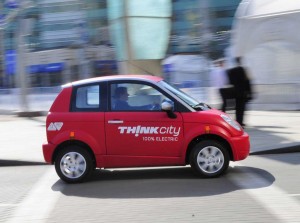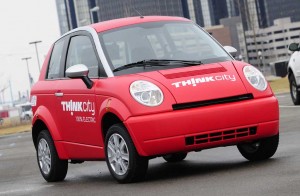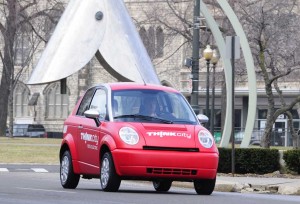
Will the City get American motorists to TH!NK more positively about battery-electric vehicles?
We’ve been reading – and writing – a lot about “electrification,” lately, especially here on TheDetroitBureau.com. To hear the proponents, everyone from General Motors’ retiring car czar, Bob Lutz, all the way up to President Barack Obama, batteries are the future of the auto industry.
Sure, as our new review of the third-generation Toyota Prius suggests, the hybrid-electric vehicle is quickly coming of age. The latest gasoline-electric technology is nearly seamless and, for many – though clearly not all – American motorists, hybrids are a sound choice. We’ll have to wait to see if the even more advanced plug-in hybrids, like Chevrolet’s much-heralded Volt, will be equally enticing. Certainly, there’s a tremendous appeal to the idea of being able to run your daily commute solely on battery power, while still having a gasoline engine to fall back on should you need to make some detours.
But is there a real future for a car with nothing but a battery and a motor under its hood? That is, arguably, the ultimate goal of the electrified automobile. Forget gasoline, diesel, ethanol, used cooking grease, or whatever else you might otherwise need to tank up with. Simply find a plug, charge up and go.
Reality caught up with concept, back in the early 1980s, when California regulators tried to force the first Zero-Emission Vehicles, or ZEVs, down the throat of a reluctant auto industry and a skeptical public. Back then, the only way to meet the mandate was with the relatively inefficient batteries of the day, heavy lead-acid packs that hadn’t changed much since the legendary Thomas Edison tried to design a better battery for Henry Ford’s wife, Clara, who preferred her clean electric runabout to Henry’s smoky Model T.
California rescinded the original ZEV mandate in a messy politicized process, though their persistence in promoting clean air and better mileage has encouraged automakers and battery manufacturers alike to keep looking for solutions, and the Nickel-Metal Hydride chemistry used in the Prius and other current hybrids is far more efficient than older lead-acid batteries. Next up, we’ll be getting cars powered by the same, basic Lithium-Ion, or LIon, technology that we find in most modern cellphones and laptop computers. If the original GM EV1 had used LIon technology, some estimate it could have gone from 50 miles range to somewhere between 150 to more than 200 per charge.
We’ll soon find out, as an assortment of manufacturers are rushing a new generation of battery-electric vehicles to market. The Silicon Valley start-up, Tesla Motors, has already weighed in, though its $100,000 Roadster will only find a home with the most affluent of green-minded motorists. Nissan plans to weigh in, by 2011, with a more mainstream BEV. And others will follow – many of them non-traditional players, like Tesla, who see an opportunity to enter the normally closed automotive market, and a small wannabe named THINK.

Th!nk City: about as small as a Smart fortwo, with a European range of 112 miles and a U.S. target closer to 150 miles per charge.
The Norwegian-based Think Global has actually been around for nearly two decades, though its sales have been measured only in the single-digit thousands during that run. Briefly a Ford subsidiary, Think has had its problems, and is just getting to ready to re-emerge from bankruptcy – but with a line of new capital that could make it a serious player in the urban EV market.
We were lucky enough to get our hands on the struggling maker’s latest offering, the Th!nk City, and put it through its paces. The matte plastic-bodied two-seater is a definite head-turner, if for no other reason than that unusual body finish is adorned with stickers proclaiming its unusual powertrain to any and all passers-by.
The 2,288-pound City is about the size of a Smart fortwo, measuring 122.8 inches, nose-to-tail, 63.1 inches wide and 60.9 inches high. It’s small enough to fit in a typical parking spot, and with its astounding 14.8-foot turning radius, nimble enough to turn around inside my garage, so I didn’t need to back out my long and weaving driveway. Though the coupe is confining, with two occupants close enough to rub shoulders, there’s a surprisingly large cargo compartment right behind the seats.
When the folks handling the prototype dropped it off, I was advised to give it a top-off-charge, a surprisingly easy process, as long as there’s at least a basic 110-volt outlet nearby. Uncoiling the charger cable from the back, I plugged the three-prong jack into garage outlet, popped open the charger cover on the front left fender and slipped in the large plug. It was easy enough to do, the second time, in virtually pitch darkness.
Using a standard outlet, a full charge is a time-consuming, if not laborious, process, taking about 10 hours from a completely drained battery. A high-voltage quick charger significantly reduced the time sidelined.
Once the gauges told us we had satisfied the battery’s thirst, we headed off for a quick jaunt. As noted, the City can turn on the proverbial dime. But absent power steering, you better make sure you’ve been doing your push-ups. It takes some muscling around at low speeds. On the road, you’ll never notice.

Th!nk City features room for 2, though an optional rear seat may be offered.
What intrigues traditional gearheads, including GM’s Lutz, about electric propulsion is that it delivers maximum torque the moment the motor starts turning. So even the EverReady bunny-sized motor in the 2-seater can surprise you when you slam the throttle to the floor. During several days of driving, we found that we were seldom the last car off the stoplight, and often left other gas-powered vehicles racing to catch up.
That said, the initial torque effect fades away quickly, so by the time the speedometer needle nudges 20, you’re losing much of your momentum. Think claims a 0 to 31 mph time of 6.5 seconds, while you’ll need a frustrating (to me) 16.0 seconds to hit 50. In reality, when you’re driving around town, that’s not as frustrating as it might seem. You’ll keep up with traffic reasonably well. Until, that is, you hit the highway. This is a city car.
In Europe and Asia, a BEV like the Th!nk City might never see a limited access roadway, but we can’t imagine many Americans will limit their driving to local roads – and neither can Think, we’re pleased to hear. In current form, the coupe is given a top speed rating of an anemic 62 mph. We were grateful to discover that was a very conservative estimate. On straight-and-level roads, we were able to maintain about 72 mph, enough to nudge past the Michigan limit, but well short of the speeds even slow drivers operate at in Motown. Meanwhile, when charging steep hills – even the long I-696 overpass over I-75 – the City would fade, slipping back to somewhere in the low 60 mph range.
Richard Canny, Think Global’s CEO, tells us that a modified, U.S. version of the coupe is in the works and the target is to boost the rated top speed to around 70 – by which we hope he means the ability to nudge the City to 80 for passing. Meanwhile, the current European-edition range of 112 miles should jump closer to 150.
With battery vehicles, range is not an absolute. The faster you go, the faster you drain the battery. You’ll lose mileage by running your headlights, your heater, even blasting the radio. And forget about air conditioning, that energy-sucking luxury, like power steering, is not to be had, though at least Think did provide power mirrors, which aren’t likely to be used enough to make a measurable difference in range.
Getting mileage up will depend on several factors, including changes to both powertrain hardware and software, but the primary factor is the battery itself. The current package relies on a high-temperature sodium-chloride cell. It’s a temperamental chemistry and will actually drain itself to remain warm enough to operate. You couldn’t leave this sort of battery untended for a long period of time. If it cooled off too much, the battery would be permanently destroyed.
To the credit of Think engineers, the City has been designed to be a plug-and-play piece of hardware, just like the typical computer. A variety of alternative batteries could be substituted. Think is currently working with several potential Lithium-Ion vendors, who could be brought on board with the planned launch of a City assembly plant, in 2010, here in the U.S. It’s an ambitious project for a tiny company.
Power and range are dominating factors when it comes to a BEV. If you can live with those limitations, you start thinking about other matters, like comfort and convenience. Seating is tight, but that large cargo hold is a plus. The lack of covered and concealed storage, such as a center console or even a glovebox is a glaring weakness.
The doors are heavy and often take two tries to close. We imagine that will be fixed before U.S. production begins. There are other issues to address, as well. Battery cars are surprisingly quiet, so much so you might not notice when one blows by. For occupants, there’s the stumps-in-the-swamp syndrome, where sounds normally masked by the roar of an internal combustion engine become all too apparent.
Road noise is acceptable, and so is City’s wind noise. But there’s that foghorn, a note that sounds like a tuba going through a meat grinder which, we’re told, is from the braking system. It desperately needs to be dealt with.
The other concern is seating. We can deal with the jouncing that a car with such a short wheelbase experiences, especially on rough Michigan pavement. But these seats are barely post-buckboard. They lend little support and seem to have a brace designed solely to dig into, rather than support, your lumbar. You might waste any energy you save on your EV heating up the water for a long soak in a hot tub.
Of course, we may be asking a lot for a little car, and one expected to carry an equally small price tag. Think’s target is around $20,000. For the car, that is. In an interesting approach that other EV makers are considering, Think plans to sell the vehicle itself but then lease the battery for a fee of around $90 a month. Considering electric power will run you barely 10 percent what gas would cost, mile-per-mile, that should still yield a bargain and, as Canney suggests, you won’t have to worry about replacing the battery when it eventually wears down. That will be built into the lease.
Would we buy a Th!nk City? Certainly not as our primary vehicle, but that’s not the intent. It’s a smart (not that Smart) alternative for everyday chores and commutes that should save significantly on fuel and, if your utility is reasonable green, it might reduce the production of global warming CO2. We’re hoping for some necessary refinements in the Th!nk City before the U.S. version arrives. If the Norwegian maker delivers, and if fuel prices surge anew, there just could be a ready market for this plug-and-play battery car.
